Types of Woven Fabrics – universally used fabric names
List of commonly used woven fabrics and uses | kind of woven fabrics | type of woven fabrics | woven fabric types
Woven fabrics are made by using two or more sets of yarn interlaced at right angles to each other. Much variety of fabrics are produced by weaving.
Woven fabrics are made by using two or more sets of yarn interlaced at right angles to each other. Much variety is produced by weaving. Woven fabrics are generally more durable. They can be easily cut into different shapes and are excellent for producing styles in garments. However, the raw edges ravel or fray easily and need to be protected. Fabrics having more fabric count (number of warp and weft yearns present) keep the shape well. Low-count fabrics are less durable and may snag or stretch which are established after several textile testing sessions.
Woven fabrics are manufactured in different widths depending on the end use. The fabrics used for apparel usually contain a 90 cm width. The Sheeting materials are generally made having a width of 160 cm/140cms and 150cms/180 cm.
See also: Type of Knitted Fabrics
Types of Woven Fabrics
-
Buckram Fabric
![Buckram Fabric]() It is a stiff-coated fabric made from a lightweight loosely woven fabric, impregnated with adhesives and fillers. This fabric is used as interfacing so as to provide support and shape retention to necklines, collars, belts, cuffs, waistbands, button closures etc in garments. They are also used as reinforcements for handbags and other articles.
It is a stiff-coated fabric made from a lightweight loosely woven fabric, impregnated with adhesives and fillers. This fabric is used as interfacing so as to provide support and shape retention to necklines, collars, belts, cuffs, waistbands, button closures etc in garments. They are also used as reinforcements for handbags and other articles. -
Cambric Fabric
![Cambric Fabric]() Cambric is a lightweight fabric woven in plain weave and produced with a stiff finish. It is suitable for women’s dresses and children’s dresses that require crispness.
Cambric is a lightweight fabric woven in plain weave and produced with a stiff finish. It is suitable for women’s dresses and children’s dresses that require crispness. -
Casement Fabric
![Casement Fabric]() Casement is a medium-weight cotton fabric made of closely packed thick warp yarns. Generally, it is used for curtains, table linen, and upholstery and is rarely used for dresses.
Casement is a medium-weight cotton fabric made of closely packed thick warp yarns. Generally, it is used for curtains, table linen, and upholstery and is rarely used for dresses. -
Cheese Cloth
![cheese-fabric]() It is a popular lightweight sheer fabric having an open weave. It has a low-count fabric consisting of carded yarns. Originally it was used for wrapping cheese or meat and hence the name. It is neither strong nor durable. It is finished in a variety of ways that attract the consumer. It is used not only for women’s and children’s dresses but also for drapery fabrics. Due to its open structure, it does not require much ironing.
It is a popular lightweight sheer fabric having an open weave. It has a low-count fabric consisting of carded yarns. Originally it was used for wrapping cheese or meat and hence the name. It is neither strong nor durable. It is finished in a variety of ways that attract the consumer. It is used not only for women’s and children’s dresses but also for drapery fabrics. Due to its open structure, it does not require much ironing. -
Chiffon Fabric
![Chiffon Fabric]() Chiffon fabrics are sheer, lightweight fabrics made of hard twisted yarns. Originally these are made in silk fabrics but today they are made from rayon or polyester. They are used for sarees and women’s evening wear. The fabrics encounter the problem of shrinkage.
Chiffon fabrics are sheer, lightweight fabrics made of hard twisted yarns. Originally these are made in silk fabrics but today they are made from rayon or polyester. They are used for sarees and women’s evening wear. The fabrics encounter the problem of shrinkage. -
Chintz Fabric
![chintz-fabric]() Chintz is a medium-weight, plain woven cotton yarn. It is often given a glazed finish which may be temporary or semi-permanent glazed chintz is available in a solid colour as well as printed with floral prints. These are often made from blends of cotton and polyester or rayon. They are used for skits, dresses, blouses, pyjamas, aprons, and draperies.
Chintz is a medium-weight, plain woven cotton yarn. It is often given a glazed finish which may be temporary or semi-permanent glazed chintz is available in a solid colour as well as printed with floral prints. These are often made from blends of cotton and polyester or rayon. They are used for skits, dresses, blouses, pyjamas, aprons, and draperies. -
Corduroy Fabric
![Corduroy-Fabric]() It is a cut pile fabric available in solid colours. The cut pile fibres are seen in the form of ribs on the surface. It is mainly used for pants, jeans, and shirts.
It is a cut pile fabric available in solid colours. The cut pile fibres are seen in the form of ribs on the surface. It is mainly used for pants, jeans, and shirts. -
Crepe Fabric
![crepe-fabric]() Silk fabric is originally characterized by a crinkle, puckered surface formed by highly twisted yarns in the warp or weft or both. By using ordinary yarns similar crepe effects can also be produced. Synthetic fabrics also impart a crepe effect finish. It is used for sarees, shirts, and women’s and children’s dresses.
Silk fabric is originally characterized by a crinkle, puckered surface formed by highly twisted yarns in the warp or weft or both. By using ordinary yarns similar crepe effects can also be produced. Synthetic fabrics also impart a crepe effect finish. It is used for sarees, shirts, and women’s and children’s dresses. -
Denim Fabric
![denim-fabric]() It was traditionally a yarn-dyed, warp-faced cotton twill fabric. Warp is usually coloured (mostly blue, maroon, green and brown) and the weft is white. This fabric is made of two weights for sportswear and overalls. Its use as jeans has made it very popular and so the nature of denim is also changed to suit the trend. It is often napped, printed and made with stretch yarn.
It was traditionally a yarn-dyed, warp-faced cotton twill fabric. Warp is usually coloured (mostly blue, maroon, green and brown) and the weft is white. This fabric is made of two weights for sportswear and overalls. Its use as jeans has made it very popular and so the nature of denim is also changed to suit the trend. It is often napped, printed and made with stretch yarn. -
Drill Fabric
![Drill Fabric]() It is a warp-faced twill woven fabric. It has a stiff finish. Originally it was produced in white and now it is available in solid colours. It is mainly used for pants, knickers, and uniforms.
It is a warp-faced twill woven fabric. It has a stiff finish. Originally it was produced in white and now it is available in solid colours. It is mainly used for pants, knickers, and uniforms. -
Flannel Fabric
![flannel-fabric]() Flannel is a woollen fabric woven in plain or twill weave having the characteristic soft handle. It looks like a bulky fabric due to the milling that is usually done to this fabric. Flannel fabric is used for suits and pants and infant clothing.
Flannel is a woollen fabric woven in plain or twill weave having the characteristic soft handle. It looks like a bulky fabric due to the milling that is usually done to this fabric. Flannel fabric is used for suits and pants and infant clothing.This fabric is popular as a cleaning fabric due to its extreme softness. This is also used to protect children from the cold atmosphere.
-
Gabardine Fabric
![Gabardine Fabric]() Gabardine is a closely woven, clear finished warp-faced twill fabric. It contains a number of warp yarns than weft yearns and is also more durable. It is usually woven in 2/1 or 2/2 twill and has a raised diagonal twill effect on the right side. It is largely used for raincoats, suitings, and sportswear.
Gabardine is a closely woven, clear finished warp-faced twill fabric. It contains a number of warp yarns than weft yearns and is also more durable. It is usually woven in 2/1 or 2/2 twill and has a raised diagonal twill effect on the right side. It is largely used for raincoats, suitings, and sportswear. -
Georgette Fabric
![Georgette Fabric]() Georgette is a sheer lightweight fabric, woven in plain weave. It has a characteristic rough texture produced by hard twisted ply, and yarns both in warp and weft. Originally it was made in silk, but today it is produced in rayon and polyester too. It’s mainly suitable for women’s evening wear.
Georgette is a sheer lightweight fabric, woven in plain weave. It has a characteristic rough texture produced by hard twisted ply, and yarns both in warp and weft. Originally it was made in silk, but today it is produced in rayon and polyester too. It’s mainly suitable for women’s evening wear. -
Kashmir Silk Fabric
![kashmiri-silk]() Kashmir silk is a silk fabric produced in plain weave and is either embroidered or printed. The motifs used are characteristic of Kashmir. It is used for shirts, women’s wear and sarees. Kashmir shawls are woven in twill weave and are usually embroidered with traditional Kashmiri embroidery.
Kashmir silk is a silk fabric produced in plain weave and is either embroidered or printed. The motifs used are characteristic of Kashmir. It is used for shirts, women’s wear and sarees. Kashmir shawls are woven in twill weave and are usually embroidered with traditional Kashmiri embroidery. -
Khadi Fabric
![Khadi Fabric]() Khadi is a term used for a wide variety of fabrics that are hand-spun and hand woven. They are produced in mainly one cotton fibre, blends of two or more fibres. They are known for durability and simplicity. The fabrics can be suitings dhotis overalls and household textiles.
Khadi is a term used for a wide variety of fabrics that are hand-spun and hand woven. They are produced in mainly one cotton fibre, blends of two or more fibres. They are known for durability and simplicity. The fabrics can be suitings dhotis overalls and household textiles. -
Lawn Fabric
![Lawn Fabric]() The lawn is a fine sheet, lightweight, crisp fabric either made of cotton or linen. Various finishes are given to this fabric, which the fabric is called by the name of the finish. It is mainly used as lining in a dress.
The lawn is a fine sheet, lightweight, crisp fabric either made of cotton or linen. Various finishes are given to this fabric, which the fabric is called by the name of the finish. It is mainly used as lining in a dress. -
Mulmul Fabric
![Mulmul Fabric]() It is an Indian term generally applied to fine cotton fabric slightly heavier, than muslin. These are often printed fabrics. They find use as sarees.
It is an Indian term generally applied to fine cotton fabric slightly heavier, than muslin. These are often printed fabrics. They find use as sarees. -
Muslin Fabric
![Muslin Fabric]() Muslin is a lightweight open cloth of plain weave. It may be used as grey or bleached and dyed. It is used as household textiles and dress materials. The name is derived from the city of Mosul where the fabric was first made.
Muslin is a lightweight open cloth of plain weave. It may be used as grey or bleached and dyed. It is used as household textiles and dress materials. The name is derived from the city of Mosul where the fabric was first made.It is a very light and open tabby (plain) woven fabric used for summer dresses and utility use. At first, the cloth was not always plain but could also have silk and gold thread woven into it. As the ability to spin yarns of greater fineness developed cotton was used more readily than silk. In this muslin, the motif weaves in and out of the cloth, as if it has been embroidered. In the Madras net, the motif is predominately woven on the surface.
-
Poplin Fabric
![Poplin Fabric]() Poplin is a medium weight, the cotton fabric having a fine weft rib. it is generally used for shirting, dresses, and upholstery.
Poplin is a medium weight, the cotton fabric having a fine weft rib. it is generally used for shirting, dresses, and upholstery. -
Sheeting Fabric
![Sheeting Fabric]() These are primarily used for bed coverings. They are medium-weight, closely woven fabrics woven either in plain or twin weave. Sheeting fabrics are made in different widths. High-quality cotton sheetings are made in plain weave with a width of 64″ x 58″ and in a twill weave with a width of 60″x72″.
These are primarily used for bed coverings. They are medium-weight, closely woven fabrics woven either in plain or twin weave. Sheeting fabrics are made in different widths. High-quality cotton sheetings are made in plain weave with a width of 64″ x 58″ and in a twill weave with a width of 60″x72″. -
Taffeta Fabric
![Taffeta Fabric]() Taffeta is a smooth, crisp, transparent fabric having a fine rib. Originally it is made with silk fibres but now it is also made of rayon. It has a characteristic finish which produces crispness. It is used as women’s evening wear.
Taffeta is a smooth, crisp, transparent fabric having a fine rib. Originally it is made with silk fibres but now it is also made of rayon. It has a characteristic finish which produces crispness. It is used as women’s evening wear. -
Tissue Fabric
![Tissue Fabric]() It is a fine fabric either made of silk or man-made fibre. They are characteristically interwoven with gold or silver threads. It is produced in rich colours and they are used as women’s dress material, sarees etc.
It is a fine fabric either made of silk or man-made fibre. They are characteristically interwoven with gold or silver threads. It is produced in rich colours and they are used as women’s dress material, sarees etc. -
Velvet Fabric
![Velvet Fabric]() It is a warp-cut pile fabric, originally made from silk. It is also produced in Rayon. The dense cut pile makes it very soft and lustrous. It is used as dress material for women and children. It is also produced with special high twisted yarns which are single or ply yarns. Based on the yarns used and twist given, they are named as semi violes (single yarns1x1) full voiles. (ply yarns 2×2) or half voile (double in warp and single in weft 2×1).
It is a warp-cut pile fabric, originally made from silk. It is also produced in Rayon. The dense cut pile makes it very soft and lustrous. It is used as dress material for women and children. It is also produced with special high twisted yarns which are single or ply yarns. Based on the yarns used and twist given, they are named as semi violes (single yarns1x1) full voiles. (ply yarns 2×2) or half voile (double in warp and single in weft 2×1). -
Mousseline Fabric
![Mousseline Fabric]() A term used to denote very fine clear fabrics, finer than muslins. Made of silk, wool or cotton, the weave structure is either (plain) tabby or two-and-one twill. In the 18th century, the British term referred to a fine cloth with a cotton warp and a worsted weft. In France, from the late 18th century onwards mousseline-delaines were made of very fine wool which was printed in beautiful designs. This fabric
A term used to denote very fine clear fabrics, finer than muslins. Made of silk, wool or cotton, the weave structure is either (plain) tabby or two-and-one twill. In the 18th century, the British term referred to a fine cloth with a cotton warp and a worsted weft. In France, from the late 18th century onwards mousseline-delaines were made of very fine wool which was printed in beautiful designs. This fabric
proved very popular for fashionable dress and shawl fabrics. The mousseline cloth is so fine and transparent that it is often found backed with another cloth of either satin or taffeta silk. -
Organdie / Organza Fabric
![Organdie-Organza Fabric]() Originally it is a lawn fabric which is given a stiff finish. Acid is used for this finish to make the fabric transparent and stiff. It is mainly used for women’s wear.
Originally it is a lawn fabric which is given a stiff finish. Acid is used for this finish to make the fabric transparent and stiff. It is mainly used for women’s wear.A thin light fabric in a (plain) tabby weave which, if organza, has a very stiff crisp finish; and for organdie, the finish is lighter or there is no finish, and thus the cloth is more pliable. The structure of the cloth always has more warps than wefts per inch, and the weft threads are finer than the warp threads. Illustrated is a colourful group of organza fabrics.
-
Leno Fabric
![Leno Fabric]() A fabric in which an open effect is created by causing certain thread ends or doup threads to cross over. Two threads or ends act as one thread; when a weft thread passes between them, the doup ends twist catching the weft and holding it tightly in place. Very fancy and beautiful clothes can be produced by combining the cross weaving, with other weave structures.
A fabric in which an open effect is created by causing certain thread ends or doup threads to cross over. Two threads or ends act as one thread; when a weft thread passes between them, the doup ends twist catching the weft and holding it tightly in place. Very fancy and beautiful clothes can be produced by combining the cross weaving, with other weave structures. -
Aertex Fabric
![Aertex Fabric]() A trade name for a cloth patented in Britain in 1886, which was first manufactured in 1888. The cloth traps air in between its structure, keeping the body cool in summer, and warm in winter. Two threads or ends act as one thread; when a weft thread passes between them, the doup ends twist catching the weft and holding it tightly in place. Very fancy and beautiful clothes can be produced by combining the cross weaving with other weave structures.
A trade name for a cloth patented in Britain in 1886, which was first manufactured in 1888. The cloth traps air in between its structure, keeping the body cool in summer, and warm in winter. Two threads or ends act as one thread; when a weft thread passes between them, the doup ends twist catching the weft and holding it tightly in place. Very fancy and beautiful clothes can be produced by combining the cross weaving with other weave structures. -
Madras Muslin Net Fabric
![Madras Fabric]() Madras net is used mainly for furnishing such as curtaining. The cloth is an open gauze ground cloth where an extra weft is inserted to produce a motif, this is then woven into the ground cloth. Where there is a surplus floating weft yarn this is then cut away after weaving revealing the motif, the edge of the sheared motif shows shorn ends of the weft yarn.
Madras net is used mainly for furnishing such as curtaining. The cloth is an open gauze ground cloth where an extra weft is inserted to produce a motif, this is then woven into the ground cloth. Where there is a surplus floating weft yarn this is then cut away after weaving revealing the motif, the edge of the sheared motif shows shorn ends of the weft yarn. -
Aida cloth Fabric
![Aida Fabric]() Aida cloth is a cotton fabric with a natural mesh pattern generally used for cross-stitch embroidery. The open, even-weave Aida fabrics’ natural stiffness enables the fabric the embroiders choose.
Aida cloth is a cotton fabric with a natural mesh pattern generally used for cross-stitch embroidery. The open, even-weave Aida fabrics’ natural stiffness enables the fabric the embroiders choose.



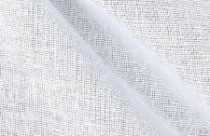 It is a stiff-coated fabric made from a lightweight loosely woven fabric, impregnated with adhesives and fillers. This fabric is used as interfacing so as to provide support and shape retention to necklines, collars, belts, cuffs, waistbands, button closures etc in garments. They are also used as reinforcements for handbags and other articles.
It is a stiff-coated fabric made from a lightweight loosely woven fabric, impregnated with adhesives and fillers. This fabric is used as interfacing so as to provide support and shape retention to necklines, collars, belts, cuffs, waistbands, button closures etc in garments. They are also used as reinforcements for handbags and other articles.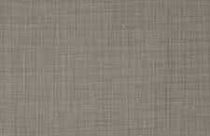 Cambric is a lightweight fabric woven in plain weave and produced with a stiff finish. It is suitable for women’s dresses and children’s dresses that require crispness.
Cambric is a lightweight fabric woven in plain weave and produced with a stiff finish. It is suitable for women’s dresses and children’s dresses that require crispness.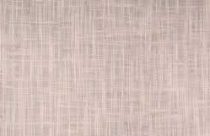 Casement is a medium-weight cotton fabric made of closely packed thick warp yarns. Generally, it is used for curtains, table linen, and upholstery and is rarely used for dresses.
Casement is a medium-weight cotton fabric made of closely packed thick warp yarns. Generally, it is used for curtains, table linen, and upholstery and is rarely used for dresses.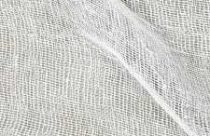 It is a popular lightweight sheer fabric having an open weave. It has a low-count fabric consisting of carded yarns. Originally it was used for wrapping cheese or meat and hence the name. It is neither strong nor durable. It is finished in a variety of ways that attract the consumer. It is used not only for women’s and children’s dresses but also for drapery fabrics. Due to its open structure, it does not require much ironing.
It is a popular lightweight sheer fabric having an open weave. It has a low-count fabric consisting of carded yarns. Originally it was used for wrapping cheese or meat and hence the name. It is neither strong nor durable. It is finished in a variety of ways that attract the consumer. It is used not only for women’s and children’s dresses but also for drapery fabrics. Due to its open structure, it does not require much ironing. Chiffon fabrics are sheer, lightweight fabrics made of hard twisted yarns. Originally these are made in silk fabrics but today they are made from rayon or polyester. They are used for sarees and women’s evening wear. The fabrics encounter the problem of shrinkage.
Chiffon fabrics are sheer, lightweight fabrics made of hard twisted yarns. Originally these are made in silk fabrics but today they are made from rayon or polyester. They are used for sarees and women’s evening wear. The fabrics encounter the problem of shrinkage.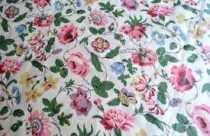 Chintz is a medium-weight, plain woven cotton yarn. It is often given a glazed finish which may be temporary or semi-permanent glazed chintz is available in a solid colour as well as printed with floral prints. These are often made from blends of cotton and polyester or rayon. They are used for skits, dresses, blouses, pyjamas, aprons, and draperies.
Chintz is a medium-weight, plain woven cotton yarn. It is often given a glazed finish which may be temporary or semi-permanent glazed chintz is available in a solid colour as well as printed with floral prints. These are often made from blends of cotton and polyester or rayon. They are used for skits, dresses, blouses, pyjamas, aprons, and draperies.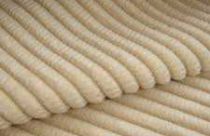 It is a cut pile fabric available in solid colours. The cut pile fibres are seen in the form of ribs on the surface. It is mainly used for pants, jeans, and shirts.
It is a cut pile fabric available in solid colours. The cut pile fibres are seen in the form of ribs on the surface. It is mainly used for pants, jeans, and shirts. Silk fabric is originally characterized by a crinkle, puckered surface formed by highly twisted yarns in the warp or weft or both. By using ordinary yarns similar crepe effects can also be produced. Synthetic fabrics also impart a crepe effect finish. It is used for sarees, shirts, and women’s and children’s dresses.
Silk fabric is originally characterized by a crinkle, puckered surface formed by highly twisted yarns in the warp or weft or both. By using ordinary yarns similar crepe effects can also be produced. Synthetic fabrics also impart a crepe effect finish. It is used for sarees, shirts, and women’s and children’s dresses. It was traditionally a yarn-dyed, warp-faced cotton twill fabric. Warp is usually coloured (mostly blue, maroon, green and brown) and the weft is white. This fabric is made of two weights for sportswear and overalls. Its use as jeans has made it very popular and so the nature of denim is also changed to suit the trend. It is often napped, printed and made with stretch yarn.
It was traditionally a yarn-dyed, warp-faced cotton twill fabric. Warp is usually coloured (mostly blue, maroon, green and brown) and the weft is white. This fabric is made of two weights for sportswear and overalls. Its use as jeans has made it very popular and so the nature of denim is also changed to suit the trend. It is often napped, printed and made with stretch yarn.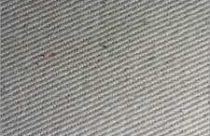 It is a warp-faced twill woven fabric. It has a stiff finish. Originally it was produced in white and now it is available in solid colours. It is mainly used for pants, knickers, and uniforms.
It is a warp-faced twill woven fabric. It has a stiff finish. Originally it was produced in white and now it is available in solid colours. It is mainly used for pants, knickers, and uniforms. Flannel is a woollen fabric woven in plain or twill weave having the characteristic soft handle. It looks like a bulky fabric due to the milling that is usually done to this fabric. Flannel fabric is used for suits and pants and infant clothing.
Flannel is a woollen fabric woven in plain or twill weave having the characteristic soft handle. It looks like a bulky fabric due to the milling that is usually done to this fabric. Flannel fabric is used for suits and pants and infant clothing.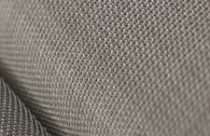 Gabardine is a closely woven, clear finished warp-faced twill fabric. It contains a number of warp yarns than weft yearns and is also more durable. It is usually woven in 2/1 or 2/2 twill and has a raised diagonal twill effect on the right side. It is largely used for raincoats, suitings, and sportswear.
Gabardine is a closely woven, clear finished warp-faced twill fabric. It contains a number of warp yarns than weft yearns and is also more durable. It is usually woven in 2/1 or 2/2 twill and has a raised diagonal twill effect on the right side. It is largely used for raincoats, suitings, and sportswear. Georgette is a sheer lightweight fabric, woven in plain weave. It has a characteristic rough texture produced by hard twisted ply, and yarns both in warp and weft. Originally it was made in silk, but today it is produced in rayon and polyester too. It’s mainly suitable for women’s evening wear.
Georgette is a sheer lightweight fabric, woven in plain weave. It has a characteristic rough texture produced by hard twisted ply, and yarns both in warp and weft. Originally it was made in silk, but today it is produced in rayon and polyester too. It’s mainly suitable for women’s evening wear. Kashmir silk is a silk fabric produced in plain weave and is either embroidered or printed. The motifs used are characteristic of Kashmir. It is used for shirts, women’s wear and sarees. Kashmir shawls are woven in twill weave and are usually embroidered with traditional Kashmiri embroidery.
Kashmir silk is a silk fabric produced in plain weave and is either embroidered or printed. The motifs used are characteristic of Kashmir. It is used for shirts, women’s wear and sarees. Kashmir shawls are woven in twill weave and are usually embroidered with traditional Kashmiri embroidery. Khadi is a term used for a wide variety of fabrics that are hand-spun and hand woven. They are produced in mainly one cotton fibre, blends of two or more fibres. They are known for durability and simplicity. The fabrics can be suitings dhotis overalls and household textiles.
Khadi is a term used for a wide variety of fabrics that are hand-spun and hand woven. They are produced in mainly one cotton fibre, blends of two or more fibres. They are known for durability and simplicity. The fabrics can be suitings dhotis overalls and household textiles. The lawn is a fine sheet, lightweight, crisp fabric either made of cotton or linen. Various finishes are given to this fabric, which the fabric is called by the name of the finish. It is mainly used as lining in a dress.
The lawn is a fine sheet, lightweight, crisp fabric either made of cotton or linen. Various finishes are given to this fabric, which the fabric is called by the name of the finish. It is mainly used as lining in a dress. It is an Indian term generally applied to fine cotton fabric slightly heavier, than muslin. These are often printed fabrics. They find use as sarees.
It is an Indian term generally applied to fine cotton fabric slightly heavier, than muslin. These are often printed fabrics. They find use as sarees.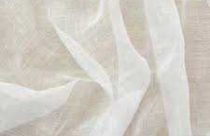 Muslin is a lightweight open cloth of plain weave. It may be used as grey or bleached and dyed. It is used as household textiles and dress materials. The name is derived from the city of Mosul where the fabric was first made.
Muslin is a lightweight open cloth of plain weave. It may be used as grey or bleached and dyed. It is used as household textiles and dress materials. The name is derived from the city of Mosul where the fabric was first made. Poplin is a medium weight, the cotton fabric having a fine weft rib. it is generally used for shirting, dresses, and upholstery.
Poplin is a medium weight, the cotton fabric having a fine weft rib. it is generally used for shirting, dresses, and upholstery.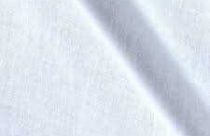 These are primarily used for bed coverings. They are medium-weight, closely woven fabrics woven either in plain or twin weave. Sheeting fabrics are made in different widths. High-quality cotton sheetings are made in plain weave with a width of 64″ x 58″ and in a twill weave with a width of 60″x72″.
These are primarily used for bed coverings. They are medium-weight, closely woven fabrics woven either in plain or twin weave. Sheeting fabrics are made in different widths. High-quality cotton sheetings are made in plain weave with a width of 64″ x 58″ and in a twill weave with a width of 60″x72″. Taffeta is a smooth, crisp, transparent fabric having a fine rib. Originally it is made with silk fibres but now it is also made of rayon. It has a characteristic finish which produces crispness. It is used as women’s evening wear.
Taffeta is a smooth, crisp, transparent fabric having a fine rib. Originally it is made with silk fibres but now it is also made of rayon. It has a characteristic finish which produces crispness. It is used as women’s evening wear.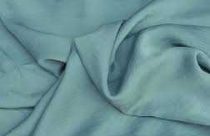 It is a fine fabric either made of silk or man-made fibre. They are characteristically interwoven with gold or silver threads. It is produced in rich colours and they are used as women’s dress material, sarees etc.
It is a fine fabric either made of silk or man-made fibre. They are characteristically interwoven with gold or silver threads. It is produced in rich colours and they are used as women’s dress material, sarees etc. It is a warp-cut pile fabric, originally made from silk. It is also produced in Rayon. The dense cut pile makes it very soft and lustrous. It is used as dress material for women and children. It is also produced with special high twisted yarns which are single or ply yarns. Based on the yarns used and twist given, they are named as semi violes (single yarns1x1) full voiles. (ply yarns 2×2) or half voile (double in warp and single in weft 2×1).
It is a warp-cut pile fabric, originally made from silk. It is also produced in Rayon. The dense cut pile makes it very soft and lustrous. It is used as dress material for women and children. It is also produced with special high twisted yarns which are single or ply yarns. Based on the yarns used and twist given, they are named as semi violes (single yarns1x1) full voiles. (ply yarns 2×2) or half voile (double in warp and single in weft 2×1). A term used to denote very fine clear fabrics, finer than muslins. Made of silk, wool or cotton, the weave structure is either (plain) tabby or two-and-one twill. In the 18th century, the British term referred to a fine cloth with a cotton warp and a worsted weft. In France, from the late 18th century onwards mousseline-delaines were made of very fine wool which was printed in beautiful designs. This fabric
A term used to denote very fine clear fabrics, finer than muslins. Made of silk, wool or cotton, the weave structure is either (plain) tabby or two-and-one twill. In the 18th century, the British term referred to a fine cloth with a cotton warp and a worsted weft. In France, from the late 18th century onwards mousseline-delaines were made of very fine wool which was printed in beautiful designs. This fabric Originally it is a lawn fabric which is given a stiff finish. Acid is used for this finish to make the fabric transparent and stiff. It is mainly used for women’s wear.
Originally it is a lawn fabric which is given a stiff finish. Acid is used for this finish to make the fabric transparent and stiff. It is mainly used for women’s wear.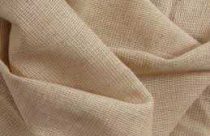 A fabric in which an open effect is created by causing certain thread ends or doup threads to cross over. Two threads or ends act as one thread; when a weft thread passes between them, the doup ends twist catching the weft and holding it tightly in place. Very fancy and beautiful clothes can be produced by combining the cross weaving, with other weave structures.
A fabric in which an open effect is created by causing certain thread ends or doup threads to cross over. Two threads or ends act as one thread; when a weft thread passes between them, the doup ends twist catching the weft and holding it tightly in place. Very fancy and beautiful clothes can be produced by combining the cross weaving, with other weave structures. A trade name for a cloth patented in Britain in 1886, which was first manufactured in 1888. The cloth traps air in between its structure, keeping the body cool in summer, and warm in winter. Two threads or ends act as one thread; when a weft thread passes between them, the doup ends twist catching the weft and holding it tightly in place. Very fancy and beautiful clothes can be produced by combining the cross weaving with other weave structures.
A trade name for a cloth patented in Britain in 1886, which was first manufactured in 1888. The cloth traps air in between its structure, keeping the body cool in summer, and warm in winter. Two threads or ends act as one thread; when a weft thread passes between them, the doup ends twist catching the weft and holding it tightly in place. Very fancy and beautiful clothes can be produced by combining the cross weaving with other weave structures.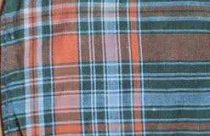 Madras net is used mainly for furnishing such as curtaining. The cloth is an open gauze ground cloth where an extra weft is inserted to produce a motif, this is then woven into the ground cloth. Where there is a surplus floating weft yarn this is then cut away after weaving revealing the motif, the edge of the sheared motif shows shorn ends of the weft yarn.
Madras net is used mainly for furnishing such as curtaining. The cloth is an open gauze ground cloth where an extra weft is inserted to produce a motif, this is then woven into the ground cloth. Where there is a surplus floating weft yarn this is then cut away after weaving revealing the motif, the edge of the sheared motif shows shorn ends of the weft yarn.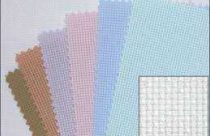 Aida cloth is a cotton fabric with a natural mesh pattern generally used for cross-stitch embroidery. The open, even-weave Aida fabrics’ natural stiffness enables the fabric the embroiders choose.
Aida cloth is a cotton fabric with a natural mesh pattern generally used for cross-stitch embroidery. The open, even-weave Aida fabrics’ natural stiffness enables the fabric the embroiders choose.
I am pleased with this information.. just needed 😌 this has a broad area.. but this few information also helpful.
Thank you
Rabeya
Oldmarkbd
This information added a little to my knowledge. Very well said…
Hey I really did like this website except I was actually looking for something more exciting and yeah so I really want something different so bye
Dear Sir
i am very pleased to your nice instruction about of Woven fabrics.
Thanks……………….
Md. Khorshed Alam
I would love more information on types of Drapery fabrics.
We read your blog and it is very beautiful and the content is also good, you have well described the types of fabrics well and I liked it so thank you, There are many types of fabrics such as cotton, rayon, felt, velvet, wool, jersey, drill, dimity, etc. All these fabrics have their own qualities and properties.
Types Of Fabrics
that are natural as well as synthetic fibers through which cloth is entwined. Natural Fibers: – Cotton and Jute from plants, Silk from silkworms. Synthetic Fibers: – Rayon, Felt, Velvet are synthetic fibers. Built by man procured from natural matter such as polyose or protein.
its really helpful
Thanks for sharing knowledge.
Need to see the image of fabric with the fabric name
I like it.
ruby is marrying simon
ayooooooooooo
others type of woven fabrics such as:—–TWILL HERRINGBONE RIPSTOP CANVAS CVC TC PC ETC .
It was good because without any kind of complication , it just submit the raw basic of fabrics. But i think it could be more happening if u add some picture as example of each kind of woven….:)